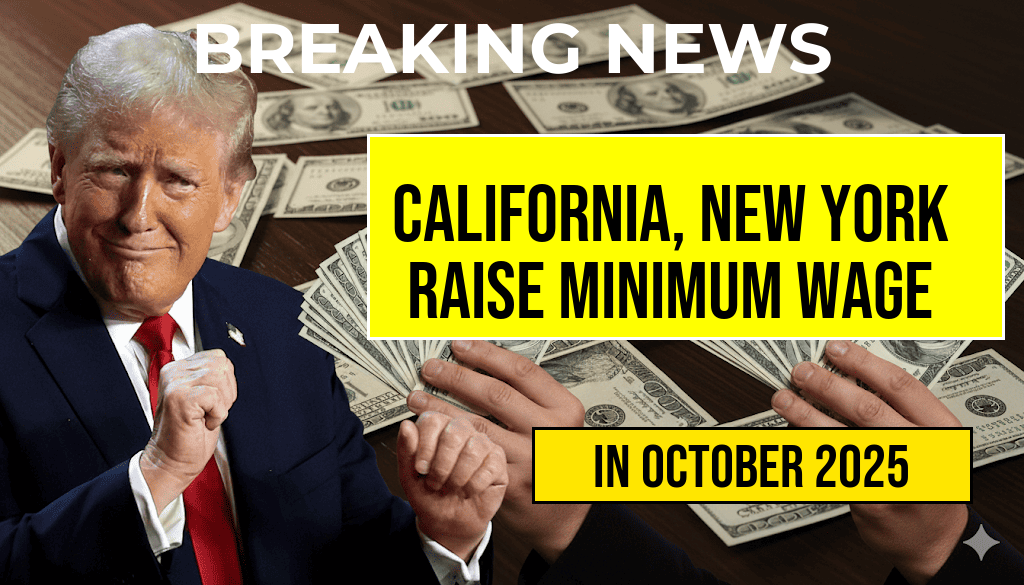California and New York have announced plans to increase their minimum wages to $16.50 per hour, a move that signals a significant shift in regional labor policies with potential ripple effects across local economies. The changes are scheduled to take effect over the coming months, with California’s increase beginning in January 2024 and New York implementing the adjustment gradually through 2025. These updates aim to address rising living costs and income disparities, but they also raise questions about impacts on small businesses, employment rates, and consumer prices in both states. As the nation observes these policy shifts, stakeholders are closely analyzing how higher wages will reshape labor markets and economic growth at the local level.
Details of the Wage Increase and Policy Context
California’s Stepwise Approach
California’s minimum wage is set to reach $16.50 per hour for all employers by January 2024, aligning with the state’s broader efforts to establish a living wage. This increase is part of a phased plan that began several years ago, with a goal of reaching $15.50 for large employers in 2023 and gradually rising to the new threshold. The state’s wage policy considers regional cost-of-living variations, with larger urban centers like Los Angeles and San Francisco already experiencing higher wage standards.
New York’s Phased Implementation
New York’s approach is more gradual, with the minimum wage for most workers in New York City rising to $16.50 per hour by the end of 2024. In the state’s upstate regions, the increase will be phased in over 2024 and early 2025, reflecting differing economic conditions across regions. This strategic rollout aims to balance wage growth with the economic realities faced by rural and suburban businesses.
Economic Implications and Industry Responses
Potential Benefits for Workers and Local Economies
- Increased purchasing power for low-income workers, potentially boosting local retail and service sectors.
- Reduction in income inequality, supporting broader economic stability.
- Enhanced employee retention and productivity in some industries, as higher wages can improve morale.
Concerns Over Business Viability and Employment
- Small businesses, especially in hospitality and retail, may face increased labor costs, pressuring profit margins.
- Some employers might reduce staffing levels or hours to offset higher wages, potentially impacting employment rates.
- Price adjustments could lead to higher costs for consumers, affecting affordability in key sectors.
Projected Impact on Consumer Prices and Employment
| Indicator | Expected Change |
|---|---|
| Consumer Prices | Potential increase of 1-3% in affected industries |
| Employment Levels | Possible stabilization or slight decline in low-wage sectors |
| Business Profit Margins | Likely compression, especially for small businesses |
Economists remain divided on the precise outcomes. While some studies suggest that moderate wage increases can stimulate local economies by increasing consumer spending, others warn that rapid or significant hikes could lead to job losses or business closures, particularly among small operators lacking the financial cushion to absorb higher payroll costs. According to data from the U.S. Bureau of Labor Statistics, regions with higher minimum wages have experienced mixed employment effects, underscoring the importance of regional economic resilience.
Legal and Political Considerations
The wage hikes in California and New York are driven by state legislation and political pressure to address income inequality and cost-of-living concerns. Both states have historically positioned themselves at the forefront of progressive labor policies, often setting benchmarks for national discussions. However, these changes are subject to legal challenges and potential adjustments based on economic feedback and lobbying efforts from business groups.
Stakeholder Perspectives
- Labor advocates emphasize the importance of living wages for worker dignity and economic fairness.
- Business associations express concerns over increased operational costs and the potential for reduced employment opportunities.
- Policy analysts highlight the need for complementary measures, such as tax incentives or support for small businesses, to ensure a smooth transition.
For additional insights into minimum wage policies and their broader economic implications, resources such as Wikipedia’s page on minimum wage and reports from Forbes provide comprehensive context.
Frequently Asked Questions
What are the new minimum wage rates in California and New York?
The minimum wage in both California and New York will be increased to $16.50 per hour.
When will the new minimum wage rates take effect?
The rate increase is scheduled to be implemented starting from the upcoming fiscal year, with specific dates varying by region within each state.
How will the wage increase impact local economies?
The wage hike is expected to boost consumer spending and improve living standards, but it may also influence business costs and employment levels in affected areas.
Which workers will benefit from the minimum wage increase?
The raise will primarily benefit low-wage workers across various industries, including retail, hospitality, and service sectors, by increasing their hourly pay.
Are there any potential challenges or concerns related to the wage hike?
Some business owners express concerns about increased operational costs and potential impacts on employment opportunities, while advocates emphasize benefits to worker welfare and economic growth.

Leave a Reply